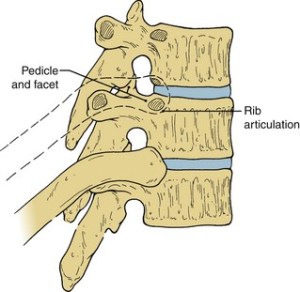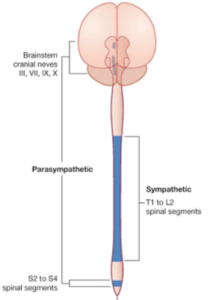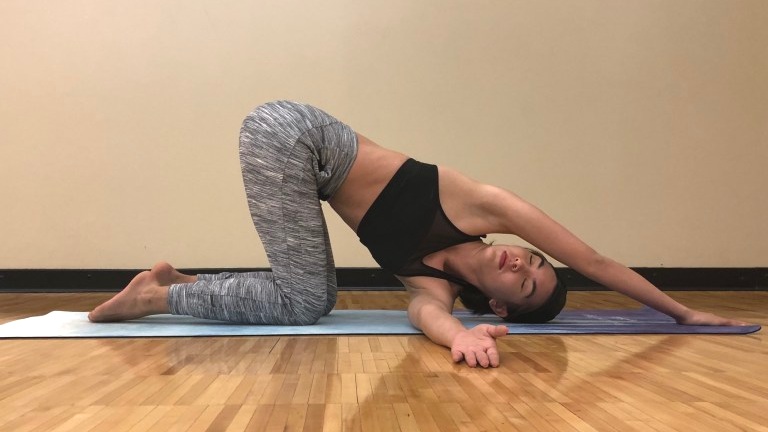Free Your Spine and the Rest Will Follow
It’s final exams time, the holiday season, last minute gift shopping, the most stressf… er.. wonderful time of the year! Tension is high and we’re all ready for that break.. to put school worries behind us and enjoy time at home with our families. For me, that time includes yoga classes with my mom, a certified instructor. This week, I’ll be focusing a lot on the thoracic spine, and all the benefits that come from thoracic flexibility.
Taking it all the way back to the first things we learn in anatomy courses, the thoracic spine is the least flexible part of the back. This is on purpose (of course, form follows function) because the thoracic vertebrae articulate with the ribs whose main purpose is to house and protect the most vital organs, the heart and lungs. The body wants to minimize flexion and extension here for protection, however, the muscles surrounding these bones can become shortened and tight leading to tension and even decreased breath capacity. When we take a deep breath in, the muscles of respiration (namely the diaphragm, intercostals, and accessory muscles including the scalenes) pull the ribs, increasing the space of the thoracic cavity and allowing air to fill the lungs.
Since the primary focus of yoga is the breath and awareness of the inhales and exhales, it is critical for a solid practice that the thoracic vertebrae and those small articulating facets are mobile and fluid so the breath is not restricted and the physical flow comes easily. Of the joints in the spine, 50% are located in the thoracic region, making it clear why mobility here is important.
Another reason why a focus on the thoracic spine is so good for yoga practice is because it neighbors one of the most important structures in the entire body, the sympathetic division of the autonomic nervous system which runs from T1 to L2 (aka the entire thoracic spine). The sympathetic nervous system is colloquially known as the “fight or flight” portion. With good thoracic mobility comes better breath control, which leads to more control of this “fight or flight” response, leading to decreased stress hormone, lower heart rates, and a sense of calm and peacefulness.
With all that being said, I might’ve activated your sympathetic nervous system by reminding you how much anatomy you’ve forgotten since your first semester of classes. (Ha!) So let’s combat that by working through some of my favorite poses for thoracic flexibility.
Parsva Balasana (Revolved Childs Pose)
Most everyone is familiar with childs pose, one of the most restorative and relaxing poses in all of the asanas. This is just a twist (literally) on that pose that deepens the stretch particularly in the thoracic spine. This pose is also known as Thread The Needle pose!
Quick tips: Bring your ear to the floor if you’re unsure what to do with your head. Push into the bottom arm and hand firmly to deepen the stretch to your desired intensity. Relax and as always, breathe deeply.
Sasangasana (Rabbit Pose)
Rabbit pose is one of my all time favorites because it provides a rare and intense stretch that you can actually feel on each side of the ribs and along the backbone. It is also a mild inversion bringing the blood to the brain, improving awareness and a sense of calm.
Quick tips: Be sure that the actual crown of your head is making contact with the floor. You can play around with hand position as they grasp your feels but I find that an inverted grip (thumbs to pinky toe side of foot) provides the most sensation through the back. Hold on tight to the heels and don’t let go!
Parighasana (Gate Pose)
As we discussed, the thoracic spine is limited in its flexion and extension and receives even less attention when it comes to lateral flexion. This deceptively simple pose opens up the sides in a stronger-than-expected stretch.
Quick tips: Make sure the hips remain stable and straight forward, not dipped to one side or the other. Imagine lengthening the distance from hipbone to armpit and to increase sensation, reach the arm higher, don’t lean further to the side. Press through the extended leg to keep the thighs active.
Parivrtta Trikonasana (Revolved Triangle Pose)
Be sure the muscles are nice and warm before attempting this pose (or any twist) and continue to breathe deeply through the twist. I absolutely love twisted postures because they are hypothesized to help keep the spongy intervertebral discs hydrated and healthy!
Quick tips: Visualize the thoracic spine lengthening away from the hips as you extend the crown of your head. Be sure to keep the neck in line with the spine and not let the head droop to either side. Ideally, your gaze will be up at the top hand but take it slow and work your way to this so you don’t torque your neck.
Purvottanasana (Upward Facing Plank)
This pose is the king of chest openers. You can feel the ribs separate and the entire chest cavity fill with breath as you inhale deeply and hold the pose. It also opens the heart and throat chakras (if you’re into that sorta thing).
Quick tips: Fight the urge to squeeze the glutes together as this will create unnecessary lumbar tension. Let those cheeks relax and focus on bringing the hips up to the ceiling. ALSO: traditionally, this pose is done with the fingertips facing the feet (as I am doing here) but new medical literature suggests turning the fingers to the side to avoid unnecessary strain on the rotator cuff muscles. (Remember SITS?)
If you try this sequence, drop a comment and let me know. If you’re looking for more yoga, check out my article Yo Azz Should Stretch That Psoas for some great hip-openers! Fit courtesy of Lululemon! If you’re in the Birmingham area, check out my favorite spot for yoga and massage, Magic City Meditation, Art, & Massage!
Love and light,
Asia







